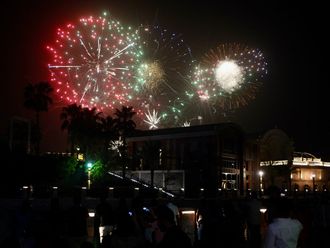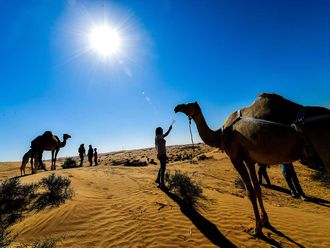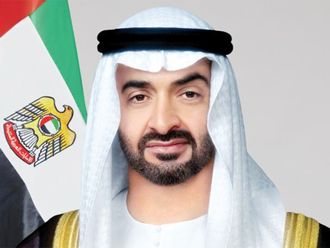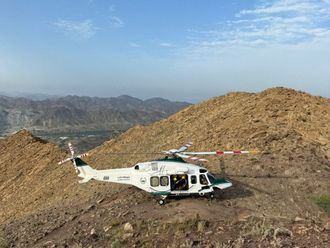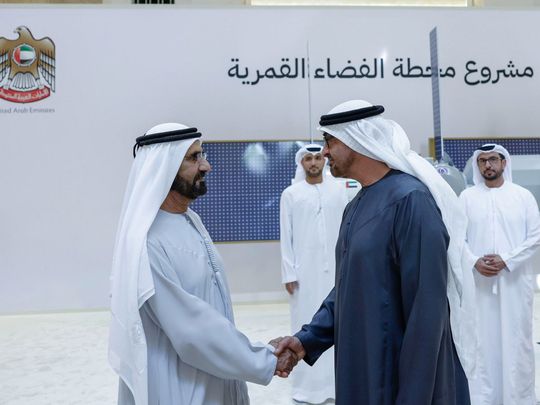
Abu Dhabi: The UAE will send the first Emirati and Arab astronaut to the lunar orbit, as part of a new space project announced on Sunday.
The UAE confirmed its participation in Nasa’s Lunar Gateway Station alongside the USA, Japan, Canada and the European Union. The Lunar Gateway will serve as humanity’s first space station around the Moon.
President His Highness Sheikh Mohamed bin Zayed Al Nahyan and His Highness Sheikh Mohammed bin Rashid Al Maktoum, Vice President and Prime Minister of the UAE and Ruler of Dubai, attended the launch of the UAE’s contributions to the historic Lunar Gateway.
On his official X account, President Sheikh Mohamed said: “I was pleased to attend with my brother Mohammed bin Rashid the launch of the UAE’s contributions to the historic Lunar Gateway, which will serve as humanity’s first space station around the Moon.”
“Through our long-term investment in space exploration and scientific innovation, the UAE is determined to work alongside its international partners to enable collective progress for all,” Sheikh Mohamed tweeted.
Meanwhile, Sheikh Mohammed bin Rashid said that as part of the nation’s contribution, the UAE will develop a complete unit weighing 10 tons for the station.
Space operations
Additionally, the UAE will establish a space operations centre within our country, along with a global centre for astronaut training.
On his official X account, Sheikh Mohammed bin Rashid said; “In the UAE, we began the new year with remarkable projects. Today, I joined President of the UAE in announcing our participation in a global scientific endeavour to construct a lunar space station, in collaboration with the United States, Canada, Japan, and the European Union.
“The lunar space station signifies humanity’s return to the moon and serves as a vital platform for launching missions to Mars,” Sheikh Mohammed added.
He noted that the work on this project will commence immediately, aligning with one of the most significant space ambitions of the coming decade.
“We are proud of our projects, our skilled workforce, and the aspirations of our youth. Filled with optimism, we look forward to a new year that promises to be the most beautiful and greatest yet for the UAE,” His Highness stated.
Its primary functions include acting as a solar-powered communication hub, facilitating scientific research, accommodating government-agency astronauts on short-term missions, and serving as a storage facility for rovers and robotic missions.
Sheikh Hamdan bin Mohammed bin Rashid Al Maktoum, Crown Prince of Dubai and Chairman of Dubai Executive Council, congratulated the UAE’s leadership, people, and the Arab world as the UAE joins the development of the Gateway Lunar Space Station, alongside the USA, Japan, Canada, and the European Union.
“This project stands out as one of the most significant international endeavours in space exploration in the 21st century. As an integral part of this project, the first Emirati and Arab astronaut will journey to the Moon upon the project’s completion in 2030,” Sheikh Hamdan said.
Emirates Airlock
“My team at the Mohammed Bin Rashid Space Centre (MBRSC) will be responsible for designing, developing, and operating the Emirates Airlock, which is the access point between the Gateway Lunar Space Station's pressurised cabin and the vacuum of space.”
“Through this project, the UAE will play a vital role in bringing humans back to the Moon after a gap of over 50 years. The Gateway will serve as a launchpad for spacewalk missions around the Moon and future missions to Mars, embodying the spirit of Sheikh Zayed’s ambition and the boundless aspirations of our nation that knows the impossible is possible,” the Dubai Crown Prince added.
NASA
Additionally, NASA Administrator Bill Nelson said: “Today, we announced the UAE’s Mohammed Bin Rashid Space Centre will provide the Crew and Science Airlock for NASA Gateway, humanity’s first space station that will orbit the Moon. This is an exciting moment for international collaboration in the cosmos and the future of human space exploration.”
This ambitious endeavour represents a collaborative multinational effort involving four prominent International Space Station partner agencies: NASA, the European Space Agency (ESA), the Japan Aerospace Exploration Agency (JAXA), and the Canadian Space Agency (CSA).
The Lunar Gateway, also known as Gateway, is the first extraterrestrial space station, strategically positioned in lunar orbit.
The nation’s contribution in the development of the Crew and Science Airlock module on the Lunar Gateway Station, aims to strengthen its global presence in the fields of space science and technology.
The UAE is the fifth partner in this project, which will be among the most important global achievements of the 21st century, and represents a historic achievement among the UAE’s accomplishments in the space sector.
Renewed ambition
This contribution comes in cooperation with the National Aeronautics and Space Administration (NASA). The project represents humankind’s renewed ambition to revisit the Moon after an absence of more than fifty years. This initiative involves landing on the Moon’s surface in preparation for upcoming missions directed towards Mars.
Airlock features
The UAE will be responsible for developing the lunar space station’s Crew and Science Airlock, a critical component for maintaining a safe environment for astronauts. This unit will act as a portal of the station, serving as the entry and exit point for missions and astronauts travelling to the Moon’s surface from the Lunar Gateway Station.
The UAE will also undertake the management and operation of the station’s Airlock. The Airlock’s length is 10 metres, its width is 4 metres, weight 10 tonnes, while the size of the entire station is: 19 x 20 x 42M.
The station will double as a space laboratory, enabling a range of scientific and technical experiments, and will have a minimum lifespan of 15 years, which is subject to extension.
The first elements of Gateway are expected to be launched by 2025, while the Emirates Airlock is scheduled to be launched by 2030.
Airlock Project phases
The Airlock development stages will include five main stages: The planning stage; the design phase; the qualification process; the flight preparation; and the operations stage.
The planning stage consists of establishing objectives, strategies and Project partners for the creation of the Airlock module, while the second stage will include the development of detailed designs and specifications for the components of the Airlock unit in order to be assembled.
The qualification process stage is characterised by testing and qualifying the Airlock unit’s components to ensure their reliability and safety for space conditions and requirements. The fourth phase of the Airlock’s development will include the preparations and launching of the space components, and integrating them into the Lunar Gateway Station.
The Mohammed Bin Rashid Space Centre (MBRSC) will be responsible for managing, maintaining and operating the Airlock, ensuring it functions effectively as part of the Gateway.
What is Artemis?
The pivotal NASA mission “Artemis” is focused on returning humans to the Moon and establishing sustainable long-term Lunar missions. The Artemis missions are expected to provide invaluable insights into lunar resources, technologies, and how to live and work on another celestial body, significantly advancing our understanding of the Moon, Mars and the expanses of the universe.
The Lunar Gateway Station is a key component of this endeavour, as humanity’s first space station orbiting the Moon. This station, built in collaboration with international and commercial partners, will provide essential functions to support astronaut health and mission objectives.
The Gateway will enable long-term astronaut stays, enhanced communication with the lunar surface, and facilitate studies on solar and cosmic radiation, as part of the programme’s vision of lunar exploration and future missions to Mars.
Significant input of the UAE
The UAE’s involvement in the Gateway marks a momentous advancement in international space collaboration. This will elevate the nation as a pivotal leader in the global space community of the future.
The UAE will hold a permanent seat and contribute scientifically to the largest programme for lunar and space exploration. It will be among the first countries to send an astronaut to the Moon, with priority access to advanced scientific and engineering data gathered by the station, enhancing its journey of knowledge.
Gateway supports sustained exploration and research in deep space, including docking ports for a variety of visiting spacecraft; space for crew to live, work, and prepare for lunar surface missions for a duration of up to 90 days; and on-board science investigations to study helio-physics, human health, and life sciences, among other areas.
MBRSC
Hamad Obaid AlMansoori, Chairman of the Mohammed Bin Rashid Space Centre (MBRSC), said, “Our participation in this project marks a new chapter in the UAE’s journey of space exploration. Guided by the ambition of our leadership, we are entering a fresh era in space exploration. Their wise vision has been a driving force behind our involvement in the development of Nasa’s Lunar Gateway Station, a global milestone showcasing the UAE’s commitment and expanding capabilities.”
Unwavering commitment
Salem Humaid Al Marri, Director-General at Mohammed Bin Rashid Space Centre, said, “We are grateful for the unwavering commitment and ambitious vision of our wise leadership, which has transformed space into a field of innovation and scientific progress. The UAE’s contribution in this project is not just a national triumph but a global achievement. It showcases our ability to actively contribute to space exploration. This project emphasises the significance of international cooperation in this field, and reflects our keenness to participate in the re-establishment of human presence on the Moon and advance space missions towards Mars.”


